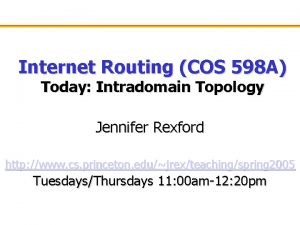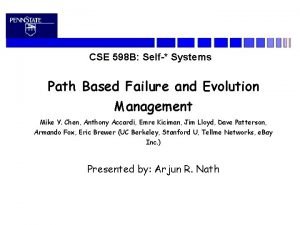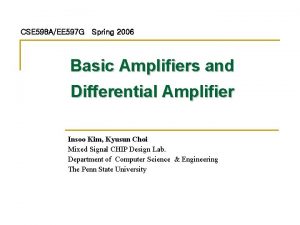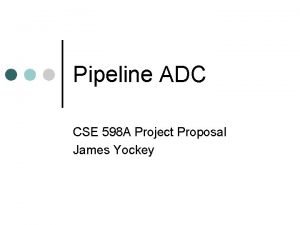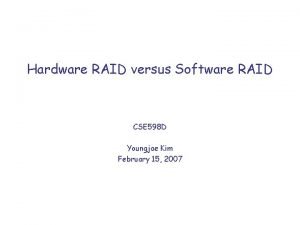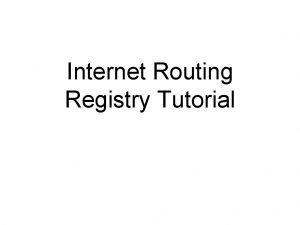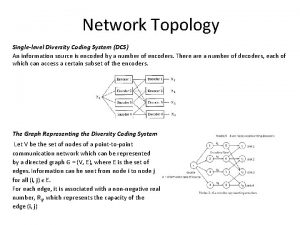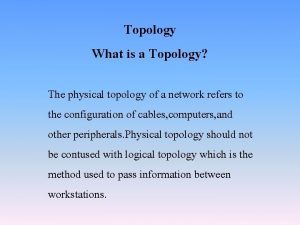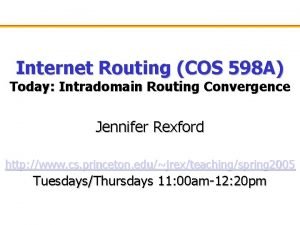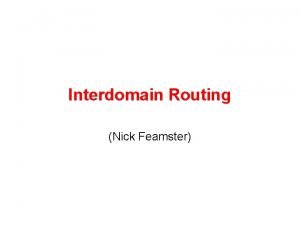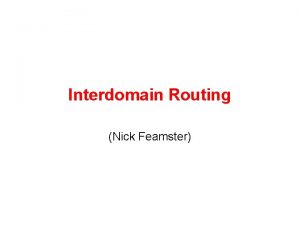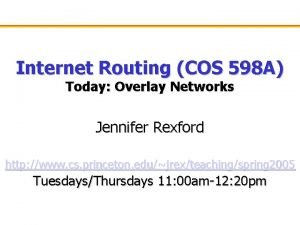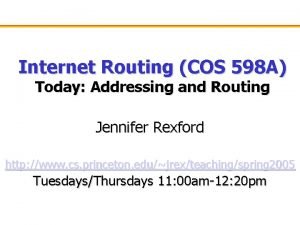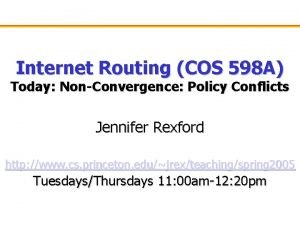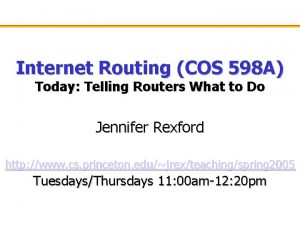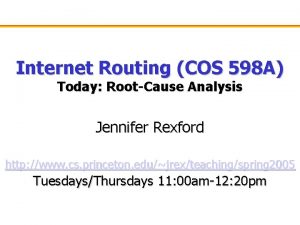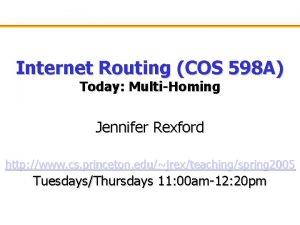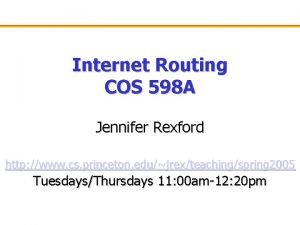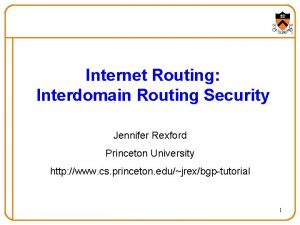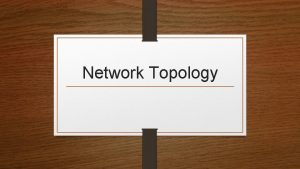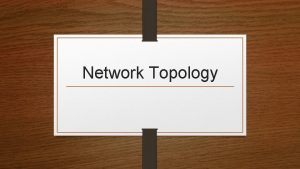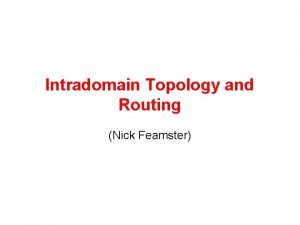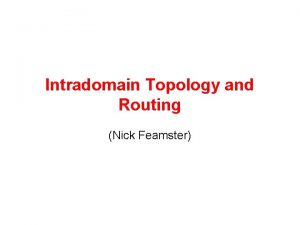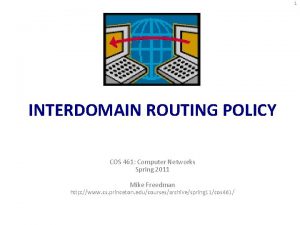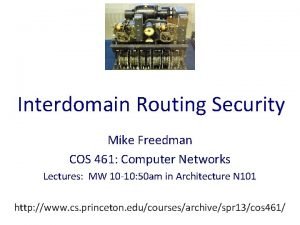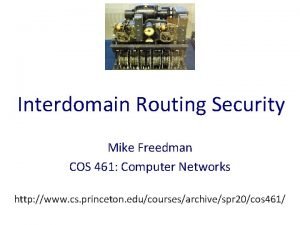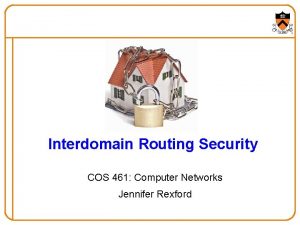Internet Routing COS 598 A Today Interdomain Topology































- Slides: 31

Internet Routing (COS 598 A) Today: Interdomain Topology Jennifer Rexford http: //www. cs. princeton. edu/~jrex/teaching/spring 2005 Tuesdays/Thursdays 11: 00 am-12: 20 pm

Outline • Interdomain topology – AS graph – Inferring the topology from routing data – Structure of the AS graph • AS relationships – Common pair-wise relationships – Inferring the relationships from routing data – Characteristics of the relationship graph • Peering policies – Example of AOL’s peering agreement

What is the AS Graph? • Node: Autonomous System • Edge: Two ASes that speak BGP to each other 4 3 5 2 1 7 6

What is an Edge, Really? • Edge in the AS graph – At least one BGP session between two ASes – Some destinations reached from one AS via the other d d AS 1 Exchange Point AS 2 AS 3

How Do You Know a Node or Edge Exists? • Consult the Whois database? – Tells which ASes have been allocated – But, might be out-of-date on who owns it – … and often doesn’t say who the neighbors are • See a path that uses the node/edge – Collect measurements of AS paths – Extract all of the nodes and edges – E. g. , AS path “ 7018 1 88” implies • Nodes: 7018, 1, and 88 • Edges: (7018, 1) and (1, 88)

Interdomain Routing: Border Gateway Protocol • ASes exchange info about who they can reach – IP prefix: block of destination IP addresses – AS path: sequence of ASes along the path • Example: a BGP route in AS 7018 shows – Prefix 12. 34. 158. 0/24 has path “ 7018, 1, 88” “ 12. 34. 158. 0/24: path (88)” “ 12. 34. 158. 0/24: path (7018, 1, 88)” 7018 88 1 data traffic 12. 34. 158. 5

Where to Get BGP Routes: Public Servers 4 7018 1221 701 7 80 3786 9. 184. 112. 0/20 3. 0. 0. 0/8 BGP sessions

Example: BGP Table Network * 3. 0. 0. 0/8 * * *> * * 9. 184. 112. 0/20 * *> * * * (“show ip bgp” at Route. Views) Next Hop Metric Loc. Prf Weight Path 205. 215. 45. 50 0 4006 701 80 i 167. 142. 3. 6 0 5056 701 80 i 157. 22. 9. 7 0 715 1 701 80 i 195. 219. 96. 239 0 8297 6453 701 80 i 195. 211. 29. 254 0 5409 6667 6427 3356 701 80 i 12. 127. 0. 249 0 7018 701 80 i 213. 200. 87. 254 0 3257 701 80 i 205. 215. 45. 50 0 4006 6461 3786 i 195. 66. 225. 254 0 5459 6461 3786 i 203. 62. 248. 4 0 1221 3786 i 167. 142. 3. 6 0 5056 6461 3786 i 195. 219. 96. 239 0 8297 6461 3786 i 195. 211. 29. 254 0 5409 6461 3786 i AS 80 is General Electric, AS 701 is UUNET, AS 7018 is AT&T AS 3786 is DACOM (Korea), AS 1221 is Telstra

Characteristics of the AS Graph • AS graph structure – High variability in node degree (“power law”) – A few very highly-connected ASes – Many ASes have only a few connections CCDF 1 All ASes have degree >= 1 0. 01 Very few have degree >= 100 0. 001 1 10 1000 AS degree

Characteristics of AS Paths • AS path may be longer than shortest AS path • Router path may be longer than shortest path 2 AS hops, 8 router hops d s 3 AS hops, 7 router hops

Problem of Missing Edges • Limited collection of paths – Some edges might never be traversed – Especially low in the AS hierarchy – … and backup links • Example: paths from two tier-1 ISPs miss an edge Sprint AT&T d 1 Harvard ? ? ? Harvard B-school d 2

Problem of Missing Nodes • Route aggregation – AS advertises a larger address block – Smaller address block not seen everywhere – Can cause an AS not to appear in BGP table C: 12. 0. 0. 0/8 A B D D: 12. 1. 0. 0/16 C E E: 12. 2. 0. 0/16 – C’s table: has paths “C”, “C D”, and “C E” – B’s table: has only path “C” for 12. 0. 0. 0/8

Research Questions • Incomplete data – How to get more data? – How much does missing data affect answers? – What kinds of questions can be answered safely?

AS Relationships

Interdomain Routing Policies • Two main decisions – Path selection: which of the paths to use? – Path export: which neighbors to tell? • Both driven by business relationships, e. g. , – Customer pays provider for Internet access – Peers find it mutually advantageous to cooperate “ 12. 34. 158. 0/24: path (2, 1)” 3 “ 12. 34. 158. 0/24: path (1)” 1 2 data traffic 12. 34. 158. 5

Customer-Provider Relationship • Customer needs to be reachable from everyone – Provider exports routes learned from customer to everyone • Customer does not want to provide transit service – Customer does not export from one provider to another Traffic to the customer Traffic from the customer d provider advertisements provider traffic customer d customer

Peer-Peer Relationship • Peers exchange traffic between customers – AS exports only customer routes to a peer – AS exports a peer’s routes only to its customers Traffic to/from the peer and its customers advertisements peer d traffic peer

Paths You Should Never See (“Invalid”) Customer-provider Peer-peer two peer edges transit through a customer

Other Kinds of Relationships • Siblings – – Same company Mutual transit service Like one bigger AS Mergers, acquisitions, … • Backup – Used only when failure – Second provider – Backup peering • Geography-specific – Customer in U. S. – Peer in Europe E A B H C D F G primary backup

AS Relationships Matter • Scientific understanding – Understanding Internet structure and evolution – Understanding why certain paths are used for traffic • Placement of Web servers – Want to be close to most customer networks • Business decisions – Selecting new peer or provider, or renegotiating relations • Security policies – Knowing which BGP routes look suspicious • Analyzing BGP convergence – Relationships have a big impact here (more later!)

Inferring AS Relationships • Top down: how routes are selected – AS relationships define routing policy – Routing policy determines the routes you see • Bottom up: how policies can be inferred – Routing data are available from public sources – The chosen routes tell you about the policy • Example: seeing path “A B C” tells you… – B permits A to transit through B to reach C – (A, B) and (B, C) cannot both be peering links – A and C are not both upstream providers of B

Type-of-Relationship Problem • Given the inputs – AS graph G(V, E) with vertices V and edges E – Set of paths P on the graph G • Find a solution that – Labels each edge with an AS relationship – Minimizes the number of “invalid” paths in P • Rich area of research work – http: //www-unix. ecs. umass. edu/~lgao/ton. ps – http: //www. cs. princeton. edu/~jrex/papers/infocom 02. pdf – http: //www. cs. berkeley. edu/~sagarwal/research/BGP-hierarchy/ – … lots of scope for algorithms-oriented research project

AS Relationship Graph (2002) • Lowest level: Stubs – Leaf nodes: no peers or downstream customers – 8898 of the 10915 ASes (82. 5% of ASes) – Ex: UC Berkeley (25), Princeton (88), AT&T Labs (6431), and INRIA (1300) • Next lowest level: Regional ISPs – Leaf nodes after successive pruning of leaf nodes – 971 ASes of the 10915 ASes (8. 9% of ASes) – Ex: Pac. Bell (5676), US West (6223), and UUNET Canada (815) • Remaining 1046 ASes: Core

AS Relationship Graph (2002), Continued • Dense core: Tier-1 providers – (Nearly) fully-connected nodes with no providers – Around 15 -20 ASes in a near-clique – Ex: Sprint, UUNET, AT&T, Verio, Level 3, C&W, … • Transit core: – ASes that peer with the dense core and each other – 129 ASes, including top providers in Europe and Asia – Ex: UUNET Europe, KDDI, and Singapore Telecom • Outer core – All of the remaining ASes in the core – 897 ASes, including large regional and national ISPs – Ex: Turkish Telecom and Minnesota Regional Network

Node Degree is Not Enough • Node degree ignores relationships – A stub AS may have many upstream providers – A core AS may have a small number of peers – Some ASes have customers that don’t have AS numbers

Ideas for Class Projects • AS relationship inference – New algorithms for inferring AS relationships – Longitudinal study of AS relationship graph – Influence of policies on measuring AS graph • AS peering policies – Analysis of incentives to peer or not – Study of how one AS can game another – Analysis of whether regulation is necessary to keep large ASes from locking out smaller ones • Alternate settlement models – Associating prices with routes? – Source-based routing with third-party control?

Peering Policies • Contracts that outline: – Operational requirements on peer network – Backbone and peering capacity requirements – Number and geographic diversity of peering points – Volume and ratio of traffic between two peers – Routing-policy requirements • AOL’s Settlement-Free Interconnection Policy – http: //www. atdn. net/settlement_free_int. shtml

AOL’s Settlement-Free Interconnection Policy • Operational requirements on a peer network – Handle a single-node outage w/o traffic impact – Single AS number – Network Operations Center staffed at all times • Backbone capacity – At least 10 gigabits/sec between 8 or more cities – Minimum peering link speed of 622 megabits/sec • Peering locations (in U. S. ) – At least four locations – Must include D. C. area, middle of country, Bay area, and NYC or Atlanta

Efficient Early-Exit Routing • Diverse peering locations Customer B – Both costs, and middle • Comparable capacity at all peering points Provider B – Can handle even load multiple peering points • Consistent routes Early-exit routing Provider A Customer A – Same destinations advertised at all points – Same AS path length for a destination at all points

AOL Routing Requirements • Consistent advertisements – All customer routes – At all peering points – With the same AS path length • Address blocks – Routes aggregated as much as possible – No address blocks smaller than /24 – Address blocks are registered (e. g. , with ARIN) • No default routing – Only send traffic to destinations AOL advertises

For Next Tuesday’s Class • Adapting routing inside an AS to the traffic – “The Revised ARPANET Routing Metric” (1989) – “Traffic Engineering With Traditional IP Routing Protocols” (survey paper, 2002) • Written one-page review of first paper – Brief summary of the paper – Reasons to accept the paper – Reasons to reject the paper – Suggestions for future research directions • Just to skim… – RFC 3272: “Overview and Principles of Internet Traffic Engineering”
 Hydrologic routing and hydraulic routing
Hydrologic routing and hydraulic routing Clock routing in vlsi
Clock routing in vlsi Difference between reservoir routing and channel routing
Difference between reservoir routing and channel routing Mark tinka
Mark tinka Ixp-598
Ixp-598 Round 716 to the nearest hundred
Round 716 to the nearest hundred 598 kpc
598 kpc Cse 598 advanced software analysis and design
Cse 598 advanced software analysis and design Cse 598
Cse 598 Evaluate the postfix expression 6523+8*+3+*
Evaluate the postfix expression 6523+8*+3+* Cse 598
Cse 598 341 rounded to the nearest ten
341 rounded to the nearest ten Cse 598
Cse 598 Irrpt
Irrpt Characteristic of fingerprint
Characteristic of fingerprint Today's lesson or today lesson
Today's lesson or today lesson Are we having class today
Are we having class today For today's meeting
For today's meeting Today's lesson or today lesson
Today's lesson or today lesson Proposal kickoff meeting agenda
Proposal kickoff meeting agenda Cos'è la fabula e cos'è l'intreccio
Cos'è la fabula e cos'è l'intreccio Sudut 315° berada di kuadran…
Sudut 315° berada di kuadran… Cos c -cos d formula
Cos c -cos d formula Il testo narrativo: schema
Il testo narrativo: schema Bentuk perkalian dari sin 8x – sin 6x =
Bentuk perkalian dari sin 8x – sin 6x = Sin inverse formula
Sin inverse formula Funções trigonométricas
Funções trigonométricas Aturan sinus
Aturan sinus Internet or internet
Internet or internet Dcs coding
Dcs coding Define physical topology
Define physical topology




